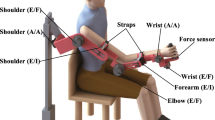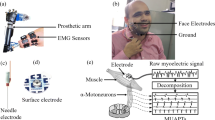Abstract
Due to the development of robotic rehabilitation technologies and modern electromyography (EMG) command-proportional control, the issues of muscle activity signal processing remain extremely relevant. In this paper we propose several options for optimizing the processing techniques for EMG signals. Our rather simple approaches improve the efficiency of the EMG interface in various parameters. In particular, the new method of signal averaging involves the calculation of two moving averages: the main “slow” average and an additional “fast” average. If the difference between the mean values exceeds a threshold, the slow mean is equated to the fast one. Another approach includes the use of a nonlinear (power) function for the proportional control of an object. The proposed approaches were tested in tasks on controlling virtual objects by 15 healthy subjects. It was found that the criteria such as the interface response time and the smoothness of movement of an object, as well as the accuracy and speed of control, were optimized. The results can be used in control systems of a wide range of robotic devices, including exoskeletons, prostheses, and wheelchairs.



Similar content being viewed by others
REFERENCES
Ackerman, E., Berkeley bionics introduces eLEGS robotic exoskeleton, IEEE Spectrum, 2010, Oct. 9. https://spectrum.ieee.org/automaton/robotics/medical-robots/berkeley-bionics-introduces-elegs-robotic-exoskeleton.
Esquenazi, A., Talaty, M., Packel, A., et al., The ReWalk powered exoskeleton to restore ambulatory function to individuals with thoracic-level motor-complete spinal cord injury, Am. J. Phys. Med. Rehabil., 2012, vol. 91, no. 11, p. 911.
Shultz, A., Robotic exoskeleton: for a better quality of life, 2012. http://www.maxonmotor.com/maxon/view/ application/EXOSKELET%0AT-AB.
Kasaoka, K. and Sankai, Y., Predictive control estimating operator’s intention for stepping-up motion by exo-skeleton type power assist system HAL, Proc. 2001 IEEE/RSJ Int. Conf. on Intelligent Robots and Systems “Expanding the Societal Role of Robotics in the the Next Millennium,” Piscataway, NJ: Inst. Electr. Electron. Eng., 2001, vol. 3, p. 1578.
Wang, S., Wang, L., Meijneke, C., et al., Design and control of the MINDWALKER exoskeleton, IEEE Trans. Neural Syst. Rehabil. Eng., 2015, vol. 23, no. 2, p. 277.
Hershler, C. and Milner, M., An optimality criterion for processing electromyographic (EMG) signals relating to human locomotion, IEEE Trans. Biomed. Eng., 1978, vol. 25, no. 5, p. 413.
Miyano, H., Masuda, T., and Sadoyama, T., A note on the time constant in low-pass filtering of rectified surface EMG, IEEE Trans. Biomed. Eng., 1980, vol. 27, no. 5, p. 274.
Xiong, F.Q. and Shwedyk, E., Some aspects of nonstationary myoelectric signal processing, IEEE Trans. Biomed. Eng., 1987, vol. 34, no. 2, p. 166.
D’Alessio, T., Some results on the optimization of a digital processor for surface EMG signals, Electromyogr. Clin. Neurophysiol., vol. 24, no. 7, p. 625.
D’Alessio, T., Analysis of a digital EMG signal processor in dynamic conditions, IEEE Trans. Biomed. Eng., 1985, vol. 32, no. 1, p. 78.
Meek, S.G. and Fetherston, S.J., Comparison of signal-to-noise ratio of myoelectric filters for prosthesis control, J. Rehabil. Res. Dev., 1992, vol. 29, no. 4, p. 9.
Park, E. and Meek, S.G., Adaptive filtering of the electromyographic signal for prosthetic control and force estimation, IEEE Trans. Biomed. Eng., 1995, vol. 42, no. 10, p. 1048.
Jacobsen, S.C., Meek, S.G., and Fullmer, R.R., Adaptive myoelectric filter, IEEE/Engineering in Medicine and Biology Society Annual Conf., Piscataway, NJ: Inst. Electr. Electron. Eng., 1984, p. 592.
Evans, H.B., Pan, Z., Parker, P.A., et al., Signal processing for proportional myoelectric control, IEEE Trans. Biomed. Eng., 1984, vol. 31, no. 2, p. 207.
Clancy, E.A., Electromyogram amplitude estimation with adaptive smoothing window length, IEEE Trans. Biomed. Eng., 1999, vol. 46, no. 6, p. 717.
Buckthorpe, M.W., Hannah, R., Pain, T.G., et al., Reliability of neuromuscular measurements during explosive isometric contractions, with special reference to electromyography normalization techniques, Muscle Nerve, 2012, vol. 46, no. 4, p. 566.
Lyu, M., Lambelet, C., Woolley, D., et al., Training wrist extensor function and detecting unwanted movement strategies in an EMG-controlled visuomotor task, Int. Conf. on Rehabilitation Robotics (ICORR), Piscataway, NJ: Inst. Electr. Electron. Eng., 2017, p. 1549.
Lobov, S.A., Mironov, V.I., Kastalskiy, I.A., et al., Combined use of command-proportional control of external robotic devices based on electromyography signals, Sovrem. Tehnol. Med., 2015, vol. 7, no. 4, p. 30.
Lobov, S., Krilova, N., Kastalskiy, I., et al., A Human-Computer Interface based on Electromyography Command-Proportional Control, Proc. 4th Int. Congr. on Neurotechnology, Electronics and Informatics, NEUROTECHNIX 2016, Setúbal: SciTePress, 2016, p. 57.
Lobov, S., Krilova, N., Kastalskiy, I., et al., Latent factors limiting the performance of sEMG-interfaces, Sensors, 2018, vol. 18, no. 4, p. 1122.
ACKNOWLEDGMENTS
This study was supported by the Ministry of Education and Science of the Russian Federation under the framework of Government Assignment No. 8.2487.2017/PCh.
Author information
Authors and Affiliations
Corresponding author
Ethics declarations
Conflict of interests. The authors declare that they have no conflict of interest.
Statement of compliance with standards of research involving humans as subjects. All subjects gave their written consent; the study was approved by the Committee for Bioethics of the Lobachevsky State University of Nizhny Novgorod (Protocol No. 6 of July 06, 2017).
Additional information
Translated by E.V. Makeeva
Rights and permissions
About this article
Cite this article
Lobov, S.A., Krylova, N.P., Anisimova, A.P. et al. Optimizing the Speed and Accuracy of an EMG Interface in Practical Applications. Hum Physiol 45, 145–151 (2019). https://doi.org/10.1134/S0362119719010109
Received:
Revised:
Accepted:
Published:
Issue Date:
DOI: https://doi.org/10.1134/S0362119719010109




